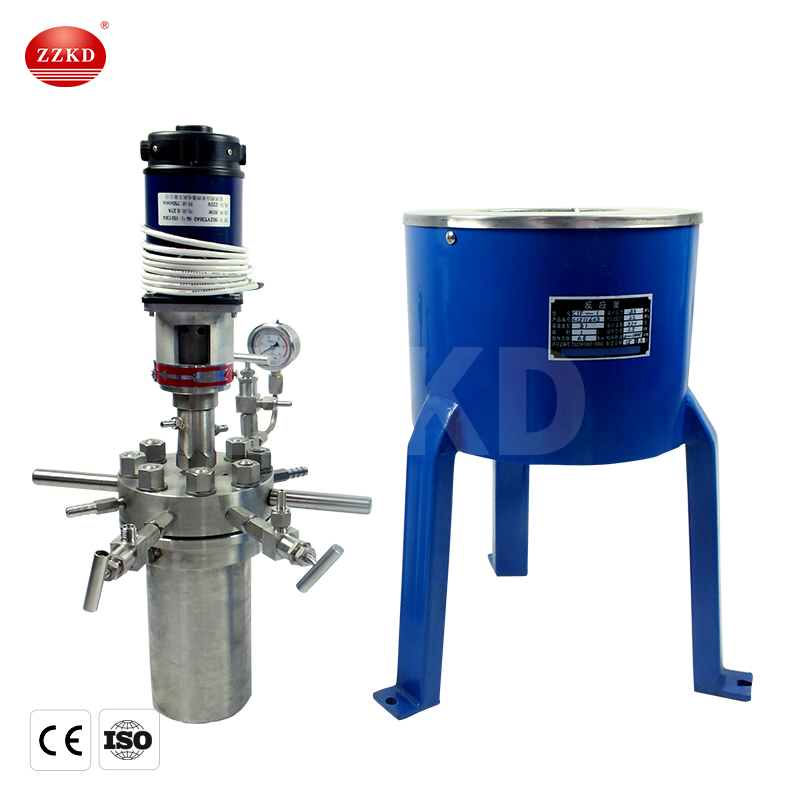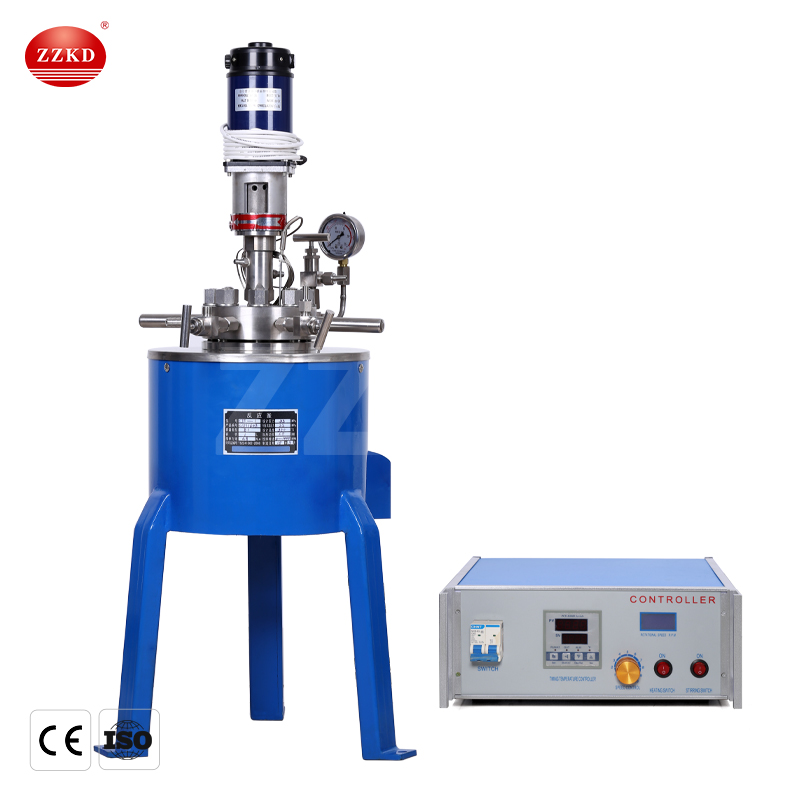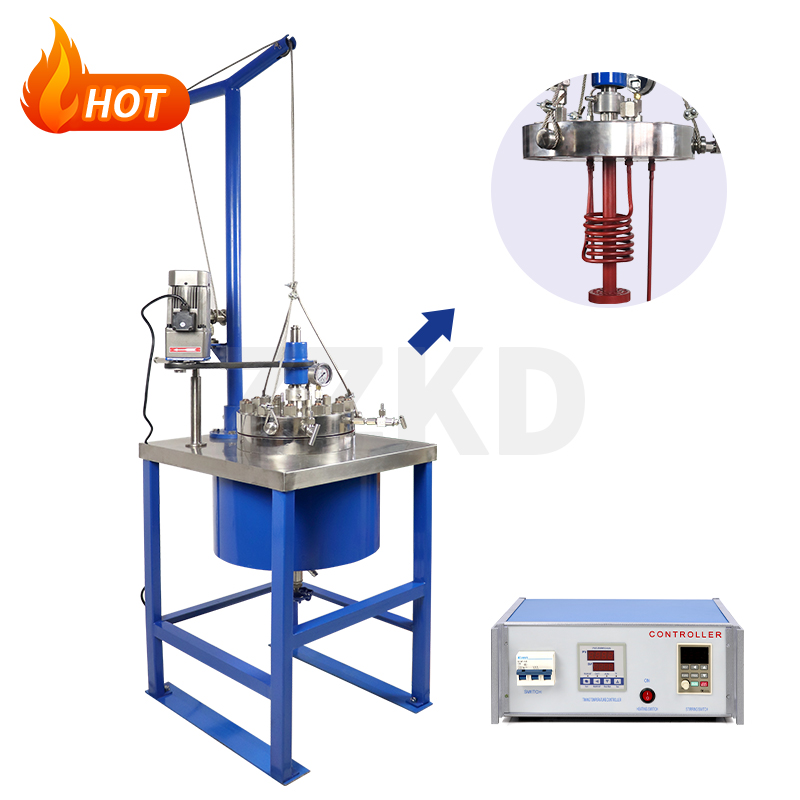High Pressure Laboratory Reactor
The high-pressure laboratory reactor is used for heating and melting the metal in a vacuum state, and then pressing the molten metal into the particle or fiber reinforcement by means of high-pressure gas to prepare high-performance composite materials and other experimental purposes. It is used for melting aluminum, copper and other metal samples. It has the functions of high pressure reactor manufacturers resistance, negative pressure and high temperature. It is especially suitable for working in the case of flammable, explosive, toxic and hydrogenated operating media. This equipment is composed of air compression system, refrigeration system, heating system, pressurization system, air intake system, vacuum system and control system, touch screen program control, whole process monitoring, sound and light alarm, kettle cover lifting, simple operation, efficient and useful.

Composition of high pressure reactor:
The reactor body of the high-pressure laboratory reactor is composed of a reaction vessel, agitator and transmission system, cooling device, safety device, heating furnace, etc.
1. The high-pressure laboratory reactor is made of stainless steel. The body of the reactor is mainly connected with the flange through threads. The cover of the reactor is a normal flat cover, and the two are fastened and connected by main bolts and nuts distributed in the circumferential direction.
2. The main sealing port of the autoclave adopts double-line sealing, which relies on the high precision and smoothness of the contact surface to achieve a good sealing effect.
3. A barrel-shaped silicon carbide furnace core is installed on the outside of the kettle, and the electric furnace wire is located in the furnace core.
4. The lid of the kettle is equipped with a pressure gauge, a bursting membrane safety device, a vapor-liquid phase valve, a temperature sensor, etc., which are convenient for users to understand the situation in the kettle, adjust the proportion of the medium in the kettle, and ensure safe operation.
5. The coupling in the high-pressure reactor is mainly composed of inner and outer magnetic rings, with a spacer in the middle. The stirrer is driven by a servo motor. By controlling the speed of the servo motor, the stirring speed can be controlled.
6. There is a speed coil on the spacer. When the integrated stirrer and the inner magnetic ring rotate, the speed measuring coil will generate an induced electromotive force, which corresponds to the stirring speed, and the stirring speed can be displayed on the tachometer.
7. The bearing adopts stainless steel bearing or high-strength electrochemical graphite, which is resistant to wear and tear and has a long maintenance period.

High quality autoclave performance:
1. The impact resistance of the high pressure reactor, the smaller the internal stress of the glass layer, the better the elasticity, the greater the hardness, the higher the flexural and compressive strength of the high pressure reactor, the better the impact resistance.
2. Withstanding voltage, the glass-lined reaction tank has excellent insulation. When the glass-lined glass is inspected with high-frequency electric spark within the specified thickness, the high-frequency electric spark cannot break down the ceramic layer.
3. The thickness of the porcelain layer is reasonable, the thickness of the porcelain layer of the glass equipment is 0.8-2.0mm, and the thickness of the porcelain layer of the accessories of the glass-lined equipment is 0.6-1.8mm.
4. Operating temperature, heating and cooling of glass-lined equipment should be carried out slowly.
5. Alkali resistance, glass-lined corrosion resistance to alkaline solution.
6. The autoclave is acid resistant and has good corrosion resistance to various organic acids, inorganic acids and organic solvents.

Autoclave installation and use:
1. The autoclave should be placed indoors, and the operating room should have an outlet directly leading to the outdoor or channel to ensure good ventilation.
2. When installing the kettle cover, the sealing surfaces between the kettle body and the kettle cover should be prevented from colliding with each other. Put the kettle cover on the kettle body in a fixed position, and tighten the main nut diagonally and symmetrically for several times. The force should be uniform, and the lid of the kettle should not be tilted to one side to achieve a good sealing effect.
3. The positive and negative nut joints only need to rotate the positive and negative nuts. The two arc sealing surfaces rotate relative to each other. All nut thread connections should be lubricated.
4. Needle valve seal, need to gently turn the valve needle and press the cover tightly to achieve a good sealing effect.
5. The controller should be placed flat on the operating table, the working environment temperature is 10-40 ℃, the relative humidity is less than 85%, and the surrounding medium does not contain conductive dust and corrosive gas.
6. Check whether the components and contacts on the panel and rear panel are normal, open the top cover, and check whether the contact of the plug-in is loose.
7. The controller should be grounded reliably.
8. Connect the wires, such as the power cord, the electric furnace wire between the controller and the kettle, the motor wire, the temperature sensor and the tachometer wire.
9. Set various parameters on the digital display, and then press the "heating" switch to turn on the electric furnace. Adjust the heating power of the electric furnace.
10. Press the "stirring" switch, the stirring motor is energized, and the indicator light on the "stirring" switch is on. Slowly turn the "speed control" knob to observe whether the motor can run normally. If there is no error, stop and hang the belt, and then restart start up.
11. After the operation, it can be cooled naturally, cooled by water or placed on the support for air cooling. After the temperature is lowered, release the pressurized gas in the kettle to reduce the pressure to normal pressure, then loosen the main nut symmetrically and evenly, then remove the main nut, then carefully remove the kettle cover and place it on the support.
12. After each operation, the residue on the kettle body and kettle cover should be removed. At present, the chemical, food, pharmaceutical and other industries need reactor equipment. However, the reactor is constantly improving its manufacturing structure to facilitate the use of customers, but it is difficult to attract customers' attention in the use of autoclaves.


